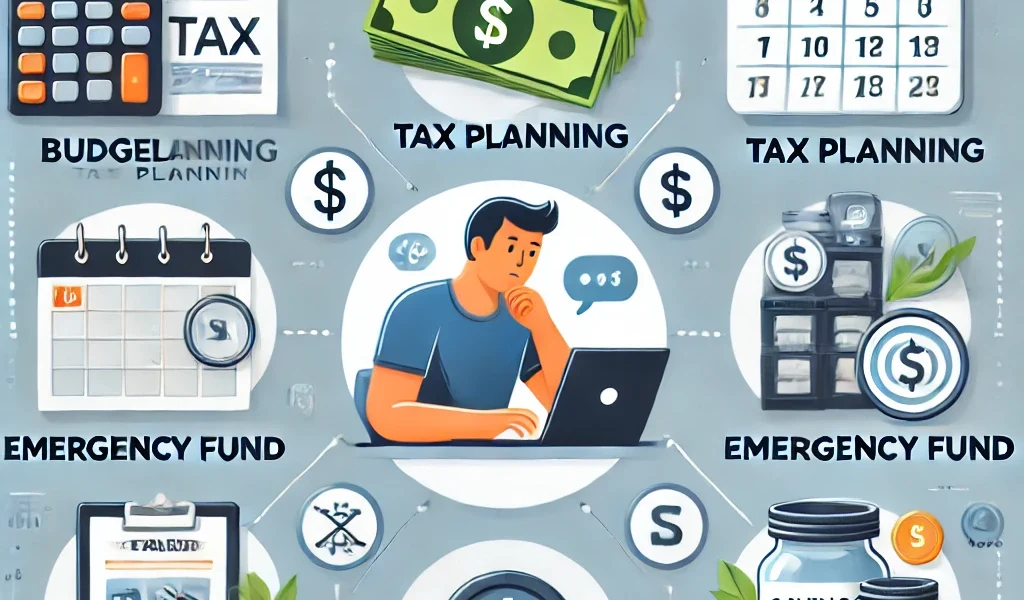Introduction
Freelancing offers the freedom to work on your terms, but it also comes with financial challenges such as inconsistent income, lack of employer benefits, and self-managed taxes. A strong financial plan can help freelancers achieve stability, save for the future, and avoid common financial pitfalls.
This guide covers essential financial planning strategies for freelancers, including budgeting, saving for taxes, managing irregular income, retirement planning, and securing health insurance.
1. Creating a Budget That Works for You
Track Your Income and Expenses
Freelancers often have fluctuating income, making it crucial to track every dollar earned and spent. Use apps like Mint, YNAB, or QuickBooks to monitor your finances.
Use the 50/30/20 Rule
- 50% Needs: Rent, utilities, groceries, health insurance
- 30% Wants: Entertainment, dining out, hobbies
- 20% Savings & Debt Repayment: Emergency fund, retirement, tax payments
Adjust this rule based on your specific financial situation.
2. Setting Up an Emergency Fund
Since freelancers don’t have a fixed paycheck, an emergency fund is essential. Aim to save at least 3-6 months’ worth of expenses in a high-yield savings account.
Tips to Build Your Emergency Fund:
- Automate monthly savings transfers
- Allocate a portion of every client payment
- Reduce unnecessary expenses until you reach your goal
3. Managing Irregular Income
Pay Yourself a Salary
- Determine an average monthly income based on past earnings
- Transfer only that amount from your business account to your personal account
- Save excess earnings for months with lower income
Diversify Your Income Streams
To mitigate financial risks, consider:
- Expanding your client base
- Offering additional services
- Creating passive income streams (e.g., online courses, digital products)
4. Tax Planning for Freelancers
Freelancers are responsible for their own taxes, including self-employment tax (Social Security & Medicare) and income tax. Here’s how to manage them effectively:
Set Aside Taxes from Every Payment
- Save 25-30% of your income for taxes
- Use a separate tax savings account
Make Quarterly Estimated Tax Payments
- Freelancers must pay quarterly taxes to avoid IRS penalties
- Deadlines: April 15, June 15, September 15, January 15
Deduct Business Expenses
Freelancers can lower taxable income by deducting:
- Home office expenses
- Equipment and software
- Internet and phone bills
- Professional development (courses, conferences)
5. Retirement Planning for Freelancers
Without employer-sponsored retirement plans, freelancers must set up their own. Consider these options:
1. Solo 401(k)
- Allows high contributions ($66,000 in 2023)
- Tax-deferred or Roth options available
2. SEP IRA (Simplified Employee Pension)
- Easy to set up with minimal paperwork
- Contribution limit: 25% of net earnings, up to $66,000 in 2023
3. Roth IRA
- Contributions are after-tax, but withdrawals in retirement are tax-free
- Best for those in lower tax brackets today
Start saving early to take advantage of compound interest.
6. Securing Health and Disability Insurance
Freelancers must arrange their own health insurance. Consider these options:
- Health Insurance Marketplace (ACA Plans)
- Freelancer’s Union or Industry-Specific Associations
- Short-Term Health Insurance (if between plans)
Disability insurance is also crucial. A policy that replaces at least 50-60% of your income can protect you in case of illness or injury.
7. Building Credit and Managing Debt
- Use business credit cards to separate business expenses and earn rewards
- Maintain a good credit score to secure better loan and mortgage rates
- Pay off high-interest debt before investing heavily
Conclusion
Freelancers must take a proactive approach to financial planning. By budgeting wisely, saving for taxes, managing irregular income, planning for retirement, and securing insurance, freelancers can achieve long-term financial stability and security.




